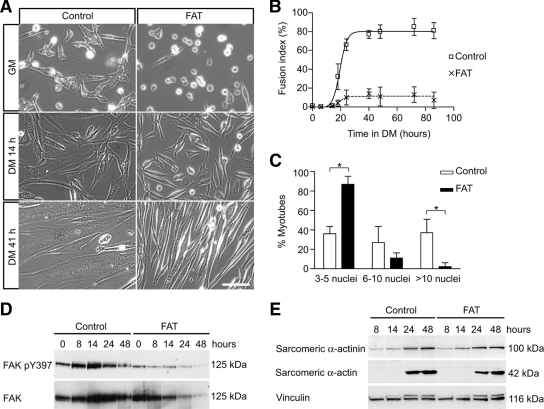Figure 3.
Inhibition of FAK by its dominant-negative FAT inhibits myoblast fusion without blocking the expression of muscle terminal differentiation genes. (A) Myoblasts infected with adenoviruses expressing GFP (“control”) or FAT-GFP (“FAT”) were induced to differentiate to determine the effect of FAK inhibition on myogenesis. The morphology of the cells was analyzed by phase contrast microscopy. Myoblast fusion was impaired in FAT-expressing cultures that were composed mostly of mono- or binucleated cells, even after 3 d in DM. Bar, 100 μm. (B) Quantitative analysis of morphological differentiation by determination of the fusion index. The fusion index in FAT-expressing cultures was dramatically decreased compared with control cultures. (C) Quantitative analysis of myonuclear content after 48 h of differentiation. This analysis demonstrates a decreased number of nuclei in FAT-expressing myotubes, with the proportion of myotubes with three to five nuclei being increased, and the proportion of myotubes with >10 nuclei being decreased compared with control cultures (*p < 0.05). (D) Myoblasts expressing GFP (“control”) and FAT-GFP (“FAT”) were cultured in DM and analyzed by Western blots. A transient up-regulation of phosphorylated FAK and FAK protein was detected during early differentiation in controls but not in FAT-expressing cultures. (E) Expression of myogenic markers. Sarcomeric α-actinin and α-actin were induced normally in FAT-expressing cells, suggesting that the expression of muscle terminal differentiation proteins was not blocked when FAK was inhibited (representative blot of at least 3 independent experiments). Unlike FAK, the expression of focal adhesion protein vinculin did not seem to change appreciably during myogenic differentiation. Note that the muscle-specific isoform, metavinculin, which is of slightly greater molecular weight and thus runs just above vinculin and is recognized by the same antibody, increased during muscle differentiation and is similarly increased in FAT-expressing and control cells.

